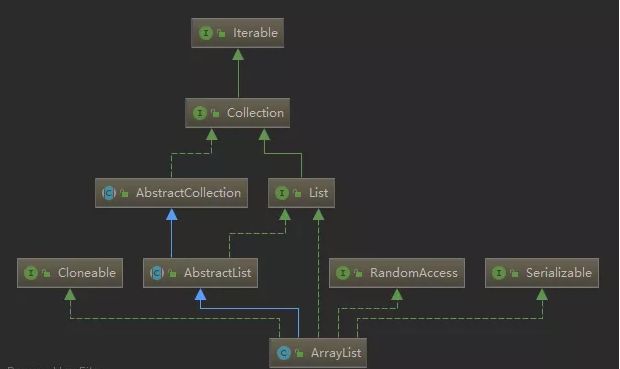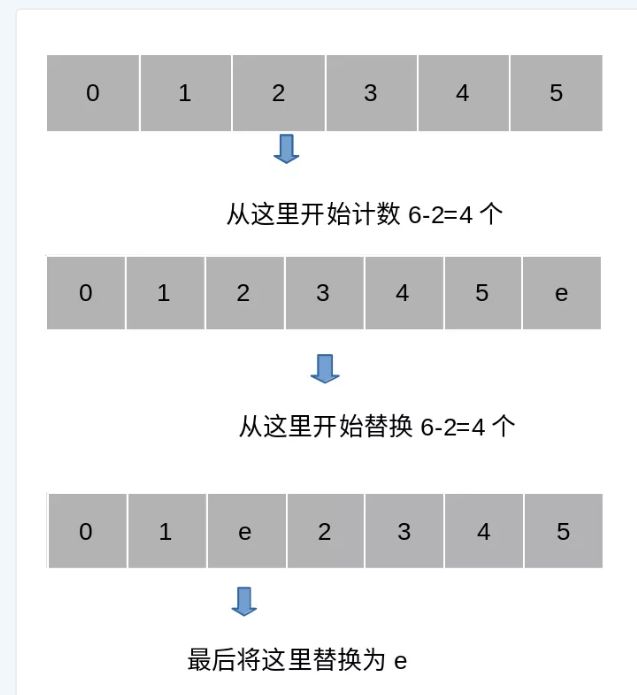深度分析ArrayList源码(JDK1.8版本)
1.简介
ArrayList是我们开发中最常用的数据存储容器之一,其底层是数组实现的,我们可以在集合中存储任意类型的数据,ArrayList是线程不安全的,非常适用于对元素进行查找,效率非常高。
2.继承体系
ArrayList实现List、RandomAccess、Cloneable、Serializable等接口。
1.Arraylist实现List,提供了基础的添加、删除、遍历等操作。
2.ArrayList实现RandomAccess,提供随机访问的能力。
3.ArrayList实现Cloneable,可以被克隆。
4.ArrayList实现Serializable,可以被序列化。
3.线程安全性
对ArrayList的操作一般分为两个步骤,改变元素的位置(大小)和操作元素。这个过程在多线程的环境下是不能保证具有原子性的,因此ArrayList在多线程下是不安全的。
4.源码分析
/**
* Default initial capacity.
*
* 默认初始化容量
*/
private static final int DEFAULT_CAPACITY = 10;
/**
* Shared empty array instance used for empty instances.
*
* 如果自定义容量为0,则会默认用它来初始化ArrayList,或者用于空数组替换
*/
private static final Object[] EMPTY_ELEMENTDATA = {};
/**
* Shared empty array instance used for default sized empty instances. We
* distinguish this from EMPTY_ELEMENTDATA to know how much to inflate when
* first element is added.
*
* 如果没有自定义容量,则会使用它来初始化ArrayList,或者用于空数组比对。
*/
private static final Object[] DEFAULTCAPACITY_EMPTY_ELEMENTDATA = {};
/**
* The array buffer into which the elements of the ArrayList are stored.
* The capacity of the ArrayList is the length of this array buffer. Any
* empty ArrayList with elementData == DEFAULTCAPACITY_EMPTY_ELEMENTDATA
* will be expanded to DEFAULT_CAPACITY when the first element is added.
*
* 这就是ArrayList底层用到的数组
* 非私有,用于简化嵌套类访问
* transient 在已经实现序列化的类中,不允许某变量序列化。
*/
transient Object[] elementData; // non-private to simplify nested class access
/**
* The size of the ArrayList (the number of elements it contains).
*
* @serial
*
* 实际ArrayList的大小/集合中元素的个数
*/
private int size;
拓展:什么是序列化?
序列化是指:将对象转换成以字节序列的形式来表示,以便于持久化和传输。
实现方法:实现序列化接口。
然后用的时候拿出来进行反序列化即可又变成java对象。
transient关键字解析
java中的transient关键字的作用,简单地说,就是让某些被修饰的变量不参加序列化。
有了transient关键字声明,transient Object[] elementData,事实上我们使用ArrayList在网络传输的时候很正常,并没有出现空值,为什么呢?
看源码:
private void writeObject(java.io.ObjectOutputStream s)
throws java.io.IOException{
// Write out element count, and any hidden stuff
// 防止序列化期间有修改
int expectedModCount = modCount;
// 写出非transient非static属性(会写出size属性)
s.defaultWriteObject();
// Write out size as capacity for behavioural compatibility with clone()
// 写出元素个数
s.writeInt(size);
// Write out all elements in the proper order.
// 依次写出元素
for (int i=0; i<size; i++) {
s.writeObject(elementData[i]);
}
if (modCount != expectedModCount) {
throw new ConcurrentModificationException();
}
}
/**
* Reconstitute the ArrayList instance from a stream (that is,
* deserialize it).
*/
private void readObject(java.io.ObjectInputStream s)
throws java.io.IOException, ClassNotFoundException {
// 声明为空数组
elementData = EMPTY_ELEMENTDATA;
// Read in size, and any hidden stuff
// 读入非transient非static属性(会读取size属性)
s.defaultReadObject();
// Read in capacity
// 读入元素个数,没什么用,只是因为写出的时候写了size属性,读的时候也要按顺序来读
s.readInt(); // ignored
if (size > 0) {
// be like clone(), allocate array based upon size not capacity
// 计算容量
int capacity = calculateCapacity(elementData, size);
SharedSecrets.getJavaOISAccess().checkArray(s, Object[].class, capacity);
// 检查是否需要扩容
ensureCapacityInternal(size);
Object[] a = elementData;
// Read in all elements in the proper order.
// 依次读取元素到数组中
for (int i=0; i<size; i++) {
a[i] = s.readObject();
}
}
}
查看writeObject()方法可知,先调用s.defaultWriteObject()方法,再把size写入到流中,再把元素一个一个的写入到流中。
一般地,只要实现了Serializable接口即可自动序列化,writeObject()和readObject()是为了自己控制序列化的方式,这两个方法必须声明为private,在java.io.ObjectStreamClass#getPrivateMethod()方法中通过反射获取到writeObject()这个方法。
在ArrayList的writeObject()方法中先调用了s.defaultWriteObject()方法,这个方法是写入非static非transient的属性,在ArrayList中也就是size属性。同样地,在readObject()方法中先调用了s.defaultReadObject()方法解析出了size属性。
那为什么不直接使用elementData中序列化,而采用上述的方式来实现序列化呢?
elementData定义为transient的优势,自己根据size序列化真实的元素,而不是根据数组的长度序列化元素,elementData是一个缓存数组,它通常会预留一些容量,等容量不足时再扩充容量,那么有些空间可能就没有实际存储元素,采用上述的方式来实现序列化,就可以保证只序列化实际存储的那些元素,而不是整个数组,从而节省空间。
ArrayList(int initialCapacity)构造方法
/**
* Constructs an empty list with the specified initial capacity.
*
* @param initialCapacity the initial capacity of the list
* @throws IllegalArgumentException if the specified initial capacity
* is negative
*/
public ArrayList(int initialCapacity) {
if (initialCapacity > 0) {
//如果传入的初始容量大于0,就新建一个数组存储元素
this.elementData = new Object[initialCapacity];
} else if (initialCapacity == 0) {
//如果传入的初始化容量等于0,使用空数组EMPTY_ELEMENTDATA
this.elementData = EMPTY_ELEMENTDATA;
} else {
//如果传入的初始化容量小于0,抛出异常。
throw new IllegalArgumentException("Illegal Capacity: "+
initialCapacity);
}
}
ArrayList()构造方法分析
/**
* Constructs an empty list with an initial capacity of ten.
*/
public ArrayList() {
//如果没有传入初始化容量,则使用空数组 DEFAULTCAPACITY_EMPTY_ELEMENTDATA
//使用这个数组是在添加第一个元素的时候就会扩容到默认大小10
this.elementData = DEFAULTCAPACITY_EMPTY_ELEMENTDATA;
}
ArrayList(Collection c) 构造方法分析
/**
* Constructs a list containing the elements of the specified
* collection, in the order they are returned by the collection's
* iterator.
*
* @param c the collection whose elements are to be placed into this list
* @throws NullPointerException if the specified collection is null
*
* 把传入集合的元素集合初始化到ArrayList中
*/
public ArrayList(Collection<? extends E> c) {
//集合转数组
elementData = c.toArray();
if ((size = elementData.length) != 0) {
//检查c.toArray()返回值是不是Object[]类型,如果不是,重新拷贝成Object[].class类型
// c.toArray might (incorrectly) not return Object[] (see 6260652)
if (elementData.getClass() != Object[].class)
elementData = Arrays.copyOf(elementData, size, Object[].class);
} else {
// replace with empty array.
//如果c是空集合,则初始化为空数组EMPTY_ELEMENTDATA
this.elementData = EMPTY_ELEMENTDATA;
}
}
为什么c.toArray();返回的有可能不是Object[]类型呢?请看下面的代码:
public class ArrayTest {
public static void main(String[] args) {
Father[] fathers = new Son[]{};
//打印的结果:class [Lcom.ls.test.Son;
System.out.println(fathers.getClass());
//打印的结果:class [Ljava.lang.String;
List<String> strList = new MyList();
System.out.println(strList.toArray().getClass());
}
}
class Father{}
class Son extends Father{}
class MyList extends ArrayList<String>{
@Override
public Object[] toArray() {
return new String[]{"1","2","3"};
}
}
add(E e)的方法
在数组的末尾追加元素,平均时间复杂度为O(1)。
/**
* Appends the specified element to the end of this list.
*
* @param e element to be appended to this list
* @return true (as specified by {@link Collection#add})
*
* 添加元素方法,添加元素到末尾,平均时间复杂度为O(1)
*/
public boolean add(E e) {
//检查是否需要扩容
ensureCapacityInternal(size + 1); // Increments modCount!!
//把元素放到最后一位
elementData[size++] = e;
return true;
}
它首先调用了ensureCapacityInternal(size + 1)方法。注意参数大小是+1 ,这个是面试考点。
private void ensureCapacityInternal(int minCapacity) {
ensureExplicitCapacity(calculateCapacity(elementData, minCapacity));
}
这个方法里面又嵌套调用了两个方法:计算容量+确保容量。
计算容量:如果elementData中是空,则返回默认容量10和大小+1的最大值,否则返回大小+1
private static int calculateCapacity(Object[] elementData, int minCapacity) {
//如果是空数组DEFAULTCAPACITY_EMPTY_ELEMENTDATA,则初始化为默认大小10.
if (elementData == DEFAULTCAPACITY_EMPTY_ELEMENTDATA) {
return Math.max(DEFAULT_CAPACITY, minCapacity);
}
return minCapacity;
}
计算完容量后,进行确保容量可用:(modCount不用理它,它用来计算修改次数)
如果size+1 > elementData.length证明数组已经放满,则增加容量,调用grow()
private void ensureExplicitCapacity(int minCapacity) {
modCount++;
// overflow-conscious code
if (minCapacity - elementData.length > 0)
//扩容
grow(minCapacity);
}
增加容量:默认1.5倍扩容。
1.获取当前数组的长度 >= oldCapacity
2.oldCapacity >> 1,表示将oldCapacity右移一位(位运算),相当于除2.再加上1,相当于新容量扩容1.5倍。
3.如果新容量小于需要的容量,则以需要的容量为准。
4.如果新容量比最大值还要大,则将新容量赋值为最大值。
5.以新容量拷贝出来一个新的数组赋值给elementData
/**
* Increases the capacity to ensure that it can hold at least the
* number of elements specified by the minimum capacity argument.
* 扩容方法
* @param minCapacity the desired minimum capacity
*/
private void grow(int minCapacity) {
// overflow-conscious code
int oldCapacity = elementData.length;
//新容量为旧容量的1.5倍。
int newCapacity = oldCapacity + (oldCapacity >> 1);
//如果新容量发现比需要的容量还小,则以需要的为准。
if (newCapacity - minCapacity < 0)
newCapacity = minCapacity;
//如果新容量已将超过最大容量了,则使用最大容量。
if (newCapacity - MAX_ARRAY_SIZE > 0)
newCapacity = hugeCapacity(minCapacity);
// minCapacity is usually close to size, so this is a win:
//以新容量拷贝出来一个新的数组。
elementData = Arrays.copyOf(elementData, newCapacity);
}
private static int hugeCapacity(int minCapacity) {
if (minCapacity < 0) // overflow
throw new OutOfMemoryError();
return (minCapacity > MAX_ARRAY_SIZE) ?
Integer.MAX_VALUE :
MAX_ARRAY_SIZE;
}
** size+1 的问题**
好了,到这里说一下为什么要size+1?
size + 1代表的含义是:
1.如果集合添加元素成功后,集合中的实际元素个数。
2.为了确保扩容不会出现错误。
假如不size+1处理,如果默认大小是0,则0 + 0 >> 1还是0。
如果size是1,则1 + 1 >> 1还是1。有人问:不是默认容量大小是10吗? 事实上,jdk1.8版本以后,ArrayList中的扩容放在add()方法中。之前放在构造方法中。我用的是1.8版本,默认所以ArrayList arrayList = new ArrayList();size应该是0。所以,size+ 1对扩容来讲很必要。

事实上上面的代码是证明不了容量大小的,因为size在只会调用add()方法时才会自增。
add(int index,E element)方法
添加元素到指定位置,平均时间复杂度为O(n)。
/**
* Inserts the specified element at the specified position in this
* list. Shifts the element currently at that position (if any) and
* any subsequent elements to the right (adds one to their indices).
*
* @param index index at which the specified element is to be inserted
* @param element element to be inserted
* @throws IndexOutOfBoundsException {@inheritDoc}
*
* 添加元素到指定位置,平均时间复杂度为O(n)
*/
public void add(int index, E element) {
//检查是否越界
rangeCheckForAdd(index);
//检查是否需要扩容
ensureCapacityInternal(size + 1); // Increments modCount!!
//将index及其之后的元素往后挪一位,则index位置处就空出来啦。
System.arraycopy(elementData, index, elementData, index + 1,
size - index);
//将元素插入到index的位置
elementData[index] = element;
//大小增1
size++;
}
在这里说一下 System.arraycopy(elementData, index, elementData, index + 1, size - index)方法:
/* @param src the source array.
* @param srcPos starting position in the source array.
* @param dest the destination array.
* @param destPos starting position in the destination data.
* @param length the number of array elements to be copied.
* @exception IndexOutOfBoundsException if copying would cause
* access of data outside array bounds.
* @exception ArrayStoreException if an element in the src
* array could not be stored into the dest array
* because of a type mismatch.
* @exception NullPointerException if either src or
* dest is null.
*/
public static native void arraycopy(Object src, int srcPos,
Object dest, int destPos,
int length);
1.Object src:原数组
2.int srcPos:从元数据的起始位置开始
3.Object dest:目标数组
4.int destPos:目标数组的开始起始位置
5.int length:要复制的数组的长度
示例:大小为6,调用我们add(2,element)方法,则会从指数= 2+1=3的位置开始,将数组元素替换为从索引起始位置为index=2,为长度6-2=4的数据。
addAll(Collection c)方法
求两个集合的并集。
public boolean addAll(Collection<? extends E> c) {
//将集合c转为数组
Object[] a = c.toArray();
int numNew = a.length;
//检查是否需要扩容
ensureCapacityInternal(size + numNew); // Increments modCount
//将c中的元素全部拷贝到数组的最后。
System.arraycopy(a, 0, elementData, size, numNew);
//大小增加c的大小
size += numNew;
//如果c不为空就返回true,否则返回false。
return numNew != 0;
}
get(int index)方法
获取指定索引位置的元素,时间复杂度为O(1)。
public E get(int index) {
//检查元素是否越界
rangeCheck(index);
//返回数组index位置的元素
return elementData(index);
}
private void rangeCheck(int index) {
if (index < 0 || index >= this.size)
throw new IndexOutOfBoundsException(outOfBoundsMsg(index));
}
@SuppressWarnings("unchecked")
E elementData(int index) {
//返回对应索引的值
return (E) elementData[index];
}
remove(int index)方法
删除指定索引位置的元素,时间复杂度为O(n)。
public E remove(int index) {
// 检查是否越界
rangeCheck(index);
modCount++;
// 获取index位置的元素
E oldValue = elementData(index);
// 如果index不是最后一位,则将index之后的元素往前挪一位
int numMoved = size - index - 1;
if (numMoved > 0)
System.arraycopy(elementData, index+1, elementData, index,
numMoved);
// 将最后一个元素删除,帮助GC
elementData[--size] = null; // clear to let GC do its work
// 返回旧值
return oldValue;
}
1.检查索引是否越界;
2.获取指定索引位置的元素;
3.如果删除的不是最后一位,则其它元素往前移一位;
4.将最后一位置为null,方便GC回收;
5.返回删除的元素。
可以看到,ArrayList删除元素的时候并没有缩容
remove(Object o)方法
删除指定元素值的元素,时间复杂度为O(n)
public boolean remove(Object o) {
if (o == null) {
for (int index = 0; index < size; index++)
// 遍历整个数组,找到元素第一次出现的位置,并将其快速删除
if (elementData[index] == null) {
fastRemove(index);
return true;
}
} else {
// 遍历整个数组,找到元素第一次出现的位置,并将其快速删除
for (int index = 0; index < size; index++)
if (o.equals(elementData[index])) {
fastRemove(index);
return true;
}
}
return false;
}
private void fastRemove(int index) {
modCount++;
// 如果index不是最后一位,则将index之后的元素往前挪一位
int numMoved = size - index - 1;
if (numMoved > 0)
System.arraycopy(elementData, index+1, elementData, index,
numMoved);
// 将最后一个元素删除,帮助GC
elementData[--size] = null; // clear to let GC do its work
}
1.找到第一个等于指定元素值的元素;
2.快速删除;
fastRemove(int index)相对于remove(int index)少了检查索引越界的操作,可见jdk将性能优化到极致。
retainAll(Collection c)方法
求两个集合的交集。
public boolean retainAll(Collection<?> c) {
// 集合c不能为null
Objects.requireNonNull(c);
// 调用批量删除方法,这时complement传入true,表示删除不包含在c中的元素
return batchRemove(c, true);
}
/**
* 批量删除元素
* complement为true表示删除c中不包含的元素
* complement为false表示删除c中包含的元素
*/
private boolean batchRemove(Collection<?> c, boolean complement) {
// 使用读写两个指针同时遍历数组
// 读指针每次自增1,写指针放入元素的时候才加1
// 这样不需要额外的空间,只需要在原有的数组上操作就可以了
final Object[] elementData = this.elementData;
int r = 0, w = 0;
boolean modified = false;
try {
// 遍历整个数组,如果c中包含该元素,则把该元素放到写指针的位置(以complement为准)
for (; r < size; r++)
if (c.contains(elementData[r]) == complement)
elementData[w++] = elementData[r];
} finally {
// 正常来说r最后是等于size的,除非c.contains()抛出了异常
// Preserve behavioral compatibility with AbstractCollection,
// even if c.contains() throws.
if (r != size) {
// 如果c.contains()抛出了异常,则把未读的元素都拷贝到写指针之后
System.arraycopy(elementData, r,
elementData, w,
size - r);
w += size - r;
}
if (w != size) {
// 将写指针之后的元素置为空,帮助GC
// clear to let GC do its work
for (int i = w; i < size; i++)
elementData[i] = null;
// 新大小等于写指针的位置(因为每写一次写指针就加1,所以新大小正好等于写指针的位置)
modCount += size - w;
size = w;
modified = true;
}
}
return modified;
}
1.遍历elementData数组;
2.如果元素在c中,则把这个元素添加到elementData数组的w位置并将w位置往后移一位;
3.遍历完之后,w之前的元素都是两者共有的,w之后(包含)的元素不是两者共有的;
4.将w之后(包含)的元素置为null,方便GC回收;
removeAll(Collection c)
求两个集合的单方向差集,只保留当前集合中不在c中的元素,不保留在c中不在当前集体中的元素。
public boolean removeAll(Collection<?> c) {
// 集合c不能为空
Objects.requireNonNull(c);
// 同样调用批量删除方法,这时complement传入false,表示删除包含在c中的元素
return batchRemove(c, false);
}
与retainAll(Collection c)方法类似,只是这里保留的是不在c中的元素。
总结
1.ArrayList内部使用数组存储元素,当数组长度不够时进行扩容,每次加一半的空间,ArrayList不会进行缩容;
2.ArrayList支持随机访问,通过索引访问元素极快,时间复杂度为O(1);
3.ArrayList添加元素到尾部极快,平均时间复杂度为O(1);
4.ArrayList添加元素到中间比较慢,因为要搬移元素,平均时间复杂度为O(n);
5.ArrayList从尾部删除元素极快,时间复杂度为O(1);
6.ArrayList从中间删除元素比较慢,因为要搬移元素,平均时间复杂度为O(n);
7.ArrayList支持求并集,调用addAll(Collection c)方法即可;
8.ArrayList支持求交集,调用retainAll(Collection c)方法即可;
9.ArrayList支持求单向差集,调用removeAll(Collection c)方法即可;
优点:
因为其底层是数组,所以修改和查询效率高。
可自动扩容(1.5倍)。
缺点:
插入和删除效率不高。
线程不安全
最后最后:手写阉割版 ArrayList
public class MyArrayList {
// 非私有,以简化嵌套类访问
// transient 在已经实现序列化的类中,不允许某变量序列化
transient Object[] elementData;
//默认容量
private static final int DEFAULT_CAPACITY = 10;
// 用于空实例的 空数组实例
private static final Object[] EMPTY_ELEMENTDATA = {};
private static final Object[] DEFAULTCAPACITY_EMPTY_ELEMENTDATA = {};
// 实际ArrayList集合大小
private int size;
/**
* 构造方法
*/
public MyArrayList(int initialCapacity) {
if (initialCapacity > 0) {
this.elementData = new Object[initialCapacity];
} else if (initialCapacity == 0) {
this.elementData = EMPTY_ELEMENTDATA;
} else {
throw new IllegalArgumentException("Illegal Capacity: "+
initialCapacity);
}
}
public MyArrayList(){
this(DEFAULT_CAPACITY);
}
public void add(Object o){
//1. 判断数据容量是否大于 elementData
ensureExplicitCapacity(size+1);
//2. 使用下标进行赋值
elementData[size++] = o;
}
private void ensureExplicitCapacity(int minCapacity){
if (size == elementData.length){
// 需要扩容,扩容1.5倍(ArrayList默认扩容1.5倍)
// 注意:如果oldCapacity值为1
int oldCapacity = elementData.length;
int newCapacity = oldCapacity + (oldCapacity >> 1);
// 如果新容量 < 最小容量, 则将最小容量赋值给新容量
// 如果 oldCapacity=1, 则 minCapacity=1+1=2 newCapacity=1+(1>>1)=1
if (newCapacity - minCapacity < 0){
newCapacity = minCapacity;
}
// 创建新数组
Object[] objects = new Object[newCapacity];
// 将数据复制给新数组
System.arraycopy(elementData, 0, objects, 0, elementData.length);
// 修改引用
elementData = objects;
}
}
public Object get(int index) {
rangeCheck(index);
return elementData[index];
}
private void rangeCheck(int index) {
if (index >= size)
throw new IndexOutOfBoundsException("下标越界");
}
/**
* 通过下标删除
* @param index
* @return
*/
public Object remove(int index) {
rangeCheck(index);
// modCount++;
// 先查出元素
Object oldValue = elementData[index];
// 找出置换结束位置
int numMoved = size - index - 1;
if (numMoved > 0)
// 从 index+1 开始 将值覆盖为 index-numMoved 的值
System.arraycopy(elementData, index+1, elementData, index, numMoved);
elementData[--size] = null; // clear to let GC do its work
return oldValue;
}
public boolean remove(Object o) {
for (int index = 0; index < size; index++){
if (o.equals(elementData[index])) {
remove(index);
return true;
}
}
return false;
}
}

